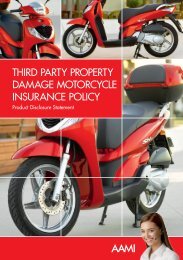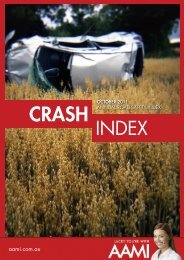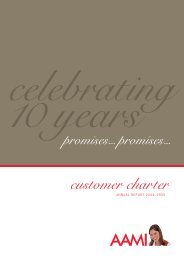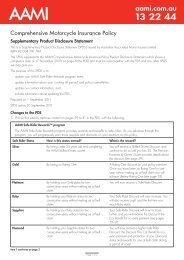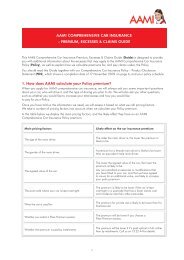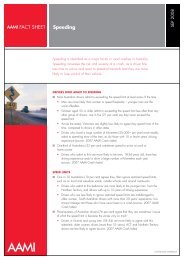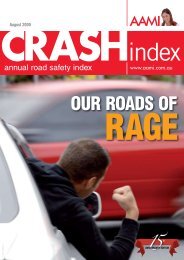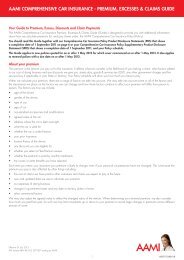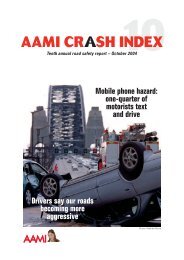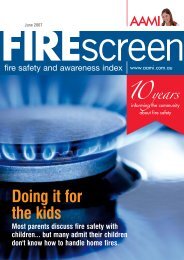AAMI Young Drivers Index 2005
AAMI Young Drivers Index 2005
AAMI Young Drivers Index 2005
Create successful ePaper yourself
Turn your PDF publications into a flip-book with our unique Google optimized e-Paper software.
16%Newspix/Trevor Pinderof young driversbelieve that drivingafter using recreationaldrugs is safer thandriving after drinkingSpeeding on country roads,near schools and from workSpeeding is a major contributor tocrashes, yet young drivers are stillignoring the danger.More than double the number of youngdrivers say they exceed the speed limit‘most of the time’ compared to otherdrivers (25 per cent versus 10 per cent).Twice as many young drivers admit theywill speed on country roads becausethey believe they will not be caught(40 per cent compared to 20 per centof other drivers).One-quarter of young drivers (27 per cent)admit they ignore restricted speed limitssuch as on local and suburban roads,outside schools and near roadworks –more than double that of other drivers(11 per cent). <strong>Young</strong> drivers are one-anda-halftimes more likely than other driversto speed to get home sooner (58 per centversus 31 per cent).<strong>Young</strong> drivers are also three times morelikely to believe they ‘will be caughtspeeding in the next year’ than otherdrivers (36 per cent versus 13 per cent).Speed cameras inobvious positionsThe risks and repercussions of speeding– both legal and lethal – are wellpublicised,yet young drivers appear tohold some disrespect for speed camerasThree-quarter of young drivers (74 percent) think the location of speed camerasis often obvious and predictablecompared with only 59 per cent ofother drivers.<strong>Young</strong> drivers are less likely than otherdrivers to believe that cameras are a‘revenue-raising exercise’ (55 per centversus 61 per cent).If they see a speed camera, half of youngdrivers (53 per cent) admit they flashtheir headlights to warn other driversversus only one-third (32 per cent) ofother drivers.Four in ten say learnertraining ‘worthless’For many years, driver instructionprograms have been widely available inAustralia, however, young drivers continueto be the most at-risk group on the road.TWICE AS MANYYOUNG DRIVERSADMIT THEYWILL SPEED ONCOUNTRY ROADSBECAUSE. THEY BELIEVETHEY WILL NOTBE CAUGHT<strong>Young</strong> drivers are the most likely toagree that the training new driversreceive is almost worthless (44 per centversus 39 per cent of other drivers).Most young drivers (90 per cent) agreethat it should be compulsory for allyoung drivers to complete a safe drivingcourse. However, when asked if theyhad undertaken a non-compulsory safedrivingcourse, young drivers were theleast likely to have done so (14 per centversus 18 per cent of other drivers).<strong>Young</strong> drivers seem to be more receptiveto shocking advertising campaigns thanother drivers. Just six in ten youngdrivers (62 per cent) feel that shockingadvertising campaigns will not changedriver behaviour, versus 73 per centof other drivers.New rules, pleaseMore than half of drivers aged 25 orolder (56 per cent) think there should bezero tolerance for P-platers caughtbreaking the road rules and that theyshould have their licence revoked.One-third of drivers aged 25 andolder (35 per cent) believe that young
Key findingsTHE BAD NEWS:THE GOOD NEWS:■ Driving under the influence OK: young drivers are twice as likely as ■ Drinking responsibly: young drivers are more likely than other driversother drivers to believe that using recreational drugs before driving to leave their car at home if they are having a few drinks (85 versusdoes not affect their driving (13 per cent versus 6 per cent).78 per cent).■ Drugs safer than alcohol: young drivers are twice as likely to believe ■ Driving under legal BAC limit: young drivers are no more likely thanthat driving after using recreational drugs is safer than driving after other drivers to have driven when probably over the drink-drive limitdrinking (16 per cent versus 8 per cent).(39 per cent versus 40 per cent).■ Text messaging while driving: more than twice as many young ■ <strong>Young</strong> less arrogant: young drivers are less likely than other driversdrivers as other drivers have sent or read a text message while driving to believe they ‘weren’t too drunk to drive’ when over the BAC limit(68 per cent versus 25 per cent). (18 per cent versus 29 per cent).■ Ignoring speed limits: one-quarter of young drivers (27 per cent) ■ Alert at the wheel: young drivers are less likely to say they haveadmit they ignore restricted speed limits on local and suburban roads, momentarily fallen asleep at the wheel (22 per cent versus 28 peroutside schools and near roadworks – more than double that of other cent of those aged 25 or older).drivers (11 per cent).■■Driver training worthless: four in ten Australian drivers (40 per cent)believe the training new drivers receive is almost worthless.The morning after: young drivers are more than one-and-a-half timesmore likely than other drivers to be concerned they would be overthe limit the day after a night of heavy drinking (67 per cent versus40 per cent).drivers should not be able to drive on theroads at times when fatalities are mostlikely to occur such as betweenmidnight–5 am.<strong>Young</strong> men still the worston the roadThe debate about who are better drivers– men or women – is a popular topic, butthe debate about whether younger orolder people are better drivers is an evenmore contentious issue.Half of Australians (55 per cent) thinkyoung men are Australia’s worst drivers,while 14 per cent believe young womenare Australia’s worst. <strong>Young</strong> drivers alsovote themselves the worst drivers: half(49 per cent) believe young men areAustralia’s worst drivers.Seven in ten drivers (72 per cent) believeyoung drivers ‘always think they arebetter than anyone’ else. However, only57 per cent of young drivers agree.A similar proportion of drivers aged over25 (67 per cent) think young drivers aretoo impatient, drive too fast and are rude;only 55 per cent of young drivers agree.Dangerous drivers: showing off,distracted by passengersSpeed and alcohol are high-profilecontributors to crashes and the road toll,but combined with a lack of drivingexperience, distractions can also severelyimpair a driver’s ability.<strong>Young</strong> drivers are more likely to havebeen a passenger when the driver hasacted dangerously (66 per centcompared to 40 per cent). Of the youngdrivers who have been a passenger in acar when the driver was drivingdangerously, most (74 per cent) said thedriver was ‘showing off’.Most young drivers (85 per cent) agreethat rowdy or intoxicated passengers canMOST YOUNGDRIVERS (85 PERCENT) AGREETHAT ROWDY ORINTOXICATEDPASSENGERSCAN BE A REALDISTRACTIONFOR YOUNGDRIVERSbe a real distraction for young drivers.However, support for restrictions onpassenger numbers for young drivers islow among those who would be targeted.More than half of older drivers (54 percent) think young drivers should not beable to carry more than two passengersin their car compared with just onequarterof young drivers (24 per cent).<strong>Young</strong> drivers are three times more likelyto say they sometimes have morepassengers in their car than there areseatbelts (14 per cent versus 5 per cent ofother drivers) and twice as likely to admitthat if there are no cars in sight, they mightsneak across a red light (14 per centversus 6 per cent of other drivers).
Mixed drinking attitudesAfter years of public awarenesscampaigns, community education andharsh penalties, young drivers continueto have varied attitudes towardsdrink-driving.<strong>Young</strong> drivers are more likely than otherdrivers to leave their cars at home ifthey are having a few drinks(85 per cent versus 78 per cent) andare also more aware of the ‘morningafter’ danger of driving the day after a‘big night’. <strong>Young</strong> drivers are more thanone-and-a-half times more likely to beconcerned they may be over the legalBAC limit the day after (67 per centversus 40 per cent of other drivers).<strong>Young</strong> drivers are the most likely toagree that it is ‘OK’ for them to driveafter a few drinks, so long as they feelYOUNG DRIVER CRASHESSTATE BREAKDOWN (%)Source: <strong>AAMI</strong> Claims Data 2004VIC (32%)NSW (11%)QLD (36%)SA (5%)TAS (6%)ACT (10%)YOUNG DRIVERSARE THE MOSTLIKELY TO AGREETHAT IT IS ‘OK’FOR THEM TODRIVE AFTER AFEW DRINKS, SOLONG AS THEYFEEL CAPABLEcapable (16 per cent versus 10 percent of other drivers). Twice as manyyoung drivers as other drivers admitthat sometimes they have taken adifferent route to avoid beingbreathalysed (36 per cent versus17 per cent). However, young driversare much less likely than other driversto believe they ‘weren’t too drunk todrive’ if they have driven over the BAClimit (18 per cent versus 29 per cent).Powernaps ignoredDriving a car when impaired by a lack ofadequate sleep can have dangerous andfar-reaching consequences for the driverand other road users, yet many youngdrivers are ignoring the need for a break.<strong>Young</strong> drivers are most likely to admitthat they would drive for more than fourhours without a break (17 per cent).Also, they are more than one-and-a-halftimes more likely to ignore the need fora powernap if tired while driving (45 percent versus 27 per cent of otherdrivers). However, young drivers areleast likely to have momentarily fallenasleep at the wheel (22 per cent versus28 per cent of others).Driving infringementsThere are strict penalties in force forspeeding, drink-driving, unlicenseddriving and other serious drivingoffences around Australia.<strong>Young</strong> drivers are more likely thanother drivers to have received drivinginfringements for speeding, drinkdrivingand going through redlights/stop signs. They are almosttwice as likely to have been fined forspeeding; they are five times morelikely to have been fined for drinkdriving;and they are three times morelikely to have been fined for running ared light/stop sign.Of those who have had their licencesuspended or cancelled, young drivershad the highest proportion of penalties,citing speeding (64 per cent) andcareless driving (19 per cent) as thereasons, while drivers aged 55-64were most likely to cite drink-driving asthe reason (49 per cent).Group of drivers Fined for Fined for Fined for runningspeeding drink-driving a red light/stop sign<strong>Young</strong> drivers (aged 18-24) 37% 5% 9%<strong>Drivers</strong> aged 25 + years 21% 1% 3%
<strong>Young</strong> drivers at risk, but need to be seen in contextDR JANE MALLICK, DIRECTOR OF CENTRE FOR YOUTH DRUG STUDIES, AUSTRALIAN DRUG FOUNDATIONThe finding that young people are morelikely to believe that using recreationaldrugs does not affect driving is a causefor concern. However, this needs to beseen in context. <strong>Young</strong> people use moreillicit drugs compared to older people,take more risks and are more likely tofeel ‘invincible’. The end result, foryoung men in particular with theirincreases in testosterone, is they areless likely to think through theconsequences of their actions comparedto older adults. So what are we to do?There are a number of approachesranging from law and detection totraining and education programs.It is promising to see young people’sattitudes and behaviour regarding drinkdriving.Today’s young people havegrown up with clear messagesregarding alcohol’s effect on driving. Itappears that the drink-drive campaignsand heightened enforcement over theyears have had a positive impact. Ibelieve in respect to drugs and driving,we need to move forward with somecaution. The association between drugsand driving, in particular the amount ofsubstance consumed and the levels ofimpairment on safety, is lessstraightforward than alcohol anddriving. There is a vast range of drugtypes (e.g. hallucinogens, stimulantsand depressants; both legal and illegal)and their effects are diverse, not just fordrug type, but there is great variabilityfrom person to person.With respect to education and training,driving instruction is one avenue.Although young people reported thatinitial driver training is worthless,significantly large numbers agreed thatit should be compulsory for all youngdrivers to do a safe driving course. It iscrucial to take note of young people’sfeedback, in order to improve trainingand have a greater impact on learning.It is very encouraging to see that youngpeople prioritise safe driving training.Clearly, attention needs to be focusedon providing better-quality initial trainingwith an emphasis on safety.Another avenue is wider educationinitiatives. Although school drugeducation is reasonably embedded inthe system, it is piecemeal in its qualityand extent of its delivery. Drug-drivingcould be a component of a widercurriculum. All of these issues need tobe seen within the wider education ofthe whole community, not just drugsand driving, but development of acaring, connected and responsiblesociety. For example, instead offocusing on the minority of‘problematic’ and/or ‘rebellious’ youth,we should be focusing on the largernumbers of young people who are insearch of a positive society, therebyharnessing positive peer influence. Inaddition, any drug-driving educationcampaign needs to be informed bywider drug education research. It iscrucial that any awareness campaignconsists of credible information with ascientific basis. Otherwise, like in widerdrug education campaigns, there isthe risk of the messages beingcounterproductive for young people,as information can be contrary totheir experiences.Although young people are a significantpart of road safety issues, they alsoneed to be seen within the widercontext. <strong>Young</strong> people too frequentlyare the scapegoat of wider societalproblems. Whilst 22 per cent of youngpeople report having mixed recreationaldrugs with driving, 13 per cent of thoseaged 25 or older doing this is alsohigh. If we do focus on young people,we need to be mindful not tomarginalise them nor create aproblematic youth self-fulfillingprophecy. Having said that, youngpeople are our future and any educationand support of them is welcome. Themore we do, in particular working withyoung people, the better off society andour roads will be.The <strong>AAMI</strong> <strong>Young</strong> <strong>Drivers</strong> <strong>Index</strong> is prepared with the statistically valid sample* of approximately police sources, which typically examine a 12-monthhelp of a nationally recognised independent research 2400 Australian adults in major population centres period. Also, smaller or unreported incidents may becompany Sweeney Research, which ensures the and regions across Australia. captured in <strong>AAMI</strong>’s research and not by others.validity of the survey methodology and findings. The Except where stated, they survey explores * The confidence interval for this sample size is plus orminus 2 per cent, which means that for the survey samplestudy is based upon a national telephone survey respondents’ experiences of crashes over their lifetime. of 2400, if the observed percentage result is 50 per cent,the chances are 95 in 100 that the range – 48-52 per centconducted in <strong>2005</strong> using a representative and <strong>AAMI</strong>’s research may differ from government and – includes the true percentage of the total population.vPRINTED ON RECYCLED PAPERPO111P115



